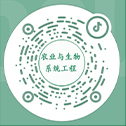| [1] |
廖小军,胡小松. 我国苹果生产、加工现状与发展对策[J]. 中国农业导报,2001,3(6):13-16.Liao Xiaojun, Hu Xiaosong. Present situation of apple production&processing and developmental strategy in China[J]. Review of China agricultural science and technology, 2001, 3(6): 13-16. (in Chinese with English abstract)
|
| [2] |
聂继云,李志霞,李海飞,等. 苹果理化品质评价指标研究[J]. 中国农业科学,2012,45(14):2895-2903.Nie Jiyun, Li Zhixia, Li Haifei, et al. Evaluation indices for apple physicochemical quality[J]. Scientia Agricultura Sinica, 2012, 45(14): 2895-2903. (in Chinese with English abstract)
|
| [3] |
聂继云,吕德国,李静,等. 苹果果实中类黄酮化合物的研究进展[J]. 园艺学报,2009,36(9):1390-1397.Nie Jiyun, Lü Deguo, Li Jing, et al. Advances in studies on flavonoids in apple fruit[J]. Acta Horticulturae Sinica, 2009, 36(9): 1390-1397. (in Chinese with English abstract)
|
| [4] |
Drogoudi Pavlina D, Pantelidis Georgios. Effects of position on canopy and harvest time on fruit physicochemical and antioxidant properties in different apple cultivars[J]. Scientia Horticulturae, 2011, 129(4): 752-760.
|
| [5] |
Mavroudis Nikolaos E, Dejmek P, Sj?holm Ingegerd. Studies on some raw material characteristics in different Swedish apple varieties [J]. Journal of Food Engineering, 2004, 62(2): 121-129.
|
| [6] |
Jha S N, Rai D R, Shrama R. Physico- chemical quality parameters and overall quality index of apple during storage[J]. Journal of food Science and technology, 2012, 49(5): 594-600.
|
| [7] |
Iglesias I, Echeverr? G, Soria Y. Differences in fruit colour development, anthocyanin content and fruit quality and consumer acceptability of eight 'Gala' apple strains[J]. Scientia Horticulturae, 2008, 119(1): 32-40.
|
| [8] |
聂继云,吕德国,李静,等. 22种苹果种质资源果实类黄酮分析[J]. 中国农业科学,2010,43(21):4455-4462.Nie Jiyun, Lü Deguo, Li Jing, et al. A preliminary study on the flavonoids in fruits of 22 apple germplasm resources[J]. Scientia Agricultura Sinica, 2010, 43(21): 4455-4462. (in Chinese with English abstract)
|
| [9] |
Abbott Judith A. Quality measurement of fruits and vegetables[J]. Postharvest Biology and Technology, 1999, 15(3): 207-225.
|
| [10] |
Kim Ki-Bok, Lee Sangdae, Kim Man-Soo, et al. Determination of apple firmness by nondestructive ultrasonic measurement[J]. Postharvest Biology and Technology, 2009, 52(1): 44-48.
|
| [11] |
Dandekar A M, Defilippi B G, Uratsu S L, et al. Effect of down-regulation of ethylene biosynthesis on fruit flavor complex in apple fruit[J]. Transgenic Research, 2004, 13(4): 373-384.
|
| [12] |
Harker F R, Gunson F A, Brookfield P L, et al. An apple a day: the influence of memory on consumer judgment of quality [J]. Food Quality Preference, 2002, 13(3): 173-179.
|
| [13] |
Oraguziea Nnadozie, Alspachb Peter, Volza Richard. Postharvest assessment of fruit quality parameters in apple using both instruments and an expert panel [J]. Postharvest Biology and Technology 2009, 52(3): 279-287.
|
| [14] |
Hampson C R, Quamme H A, Hall J W, et al. Sensory evaluation as a selection tool in apple breeding [J]. Euphytica, 2000, 111(2): 79-90.
|
| [15] |
Emira Mehinagic, Ga?lle Royer, Ronan Symoneaux. Prediction of the sensory quality of apples by physical measurements [J]. Postharvest Biology and Technology, 2004, 34(3): 257-269.
|
| [16] |
Jaeger S R, Andani Z, Wakeling I N, et al. Consumer preferences for fresh and aged apples: a cross-cultural comparison[J]. Food Quality. Preference, 1998, 9(5): 355-366.
|
| [17] |
Feliciano R P, Bravo M N, Pires M M, et al. Phenolic content and antioxidant activity of moscatel dessert wines from the setubal region in portugal[J]. Food Analytical Methods, 2009, 2(2): 142-161.
|
| [18] |
Feliciano Rodrigo P, Antunes C, Ramos A, et al. Characterization of traditional and exotic apple varieties from Portugal. Part 1-Nutritional, physiochemical and sensory evaluation[J]. Journal of functional foods, 2010, 2(1): 35-45.
|
| [19] |
Eisele Thomas A, Drake Stephen R. The partial compositional characteristics of apple juice from 175 apple varieties[J]. Journal of Food Composition and Analysis, 2005, 18(2/3): 213-221.
|
| [20] |
聂继云,刘凤之,李静,等. 制汁用苹果品质评价体系探讨[J]. 果树学报,2006,23(6):798-800.Nie Jiyun, Liu Fengzhi, Li Jing, et al. Study on the evaluation system of quality for juicing apples[J]. Journal of Fruit Science. 2006, 23(6): 798-800. (in Chinese with English abstract)
|
| [21] |
魏钦平,程述汉,丁殿东. 苹果品质评价因素的选择[J]. 中国果树,1997(4):14-15.Wei Qinping, Cheng Shuhan, Ding Diandong. Select apple quality evaluation factors[J]. China Fruits, 1997(4): 14-15. (in Chinese with English abstract)
|
| [22] |
王海波,陈学森,辛培刚,等. 几个早熟苹果品种果实糖酸组分及风味品质的评价[J]. 果树学报,2007,24(4):513-516.Wang Haibo, Chen Xuesen, Xin Peigang, et al. Study on sugar and acid constituents in several early apple cultivars and evaluation of their flavor quality [J]. Journal of Fruit Science, 2007, 24(4): 513-516. (in Chinese with English abstract)
|
| [23] |
李宝江,林桂荣,崔宽. 苹果糖酸含量与果实品质的关系[J]. 沈阳农业大学学报,1994,25(3):279-283.Li Baojiang, Lin Guirong, Cui Kuan. Studies on relationship between sugar and acid content and fruit quality of apple[J]. Journal of Shenyang Agriculture University, 1994, 25(3): 279-283. (in Chinese with English abstract)
|
| [24] |
付陈梅. 柑桔果实品质和类黄酮的含量特征及橙汁掺假检测的研究[D]. 重庆:西南大学,2008.Fu Chenmei. Research on Citrus Fruit Quality and Flavonoid and Orange Juice Adulteration Detection[D]. Chongqing: Southwest University, 2008. (in Chinese with English abstract)
|
| [25] |
余晓琴. 花椒品质评价方法及其应用研究[D]. 重庆:西南大学,2010.Yu Xiaoqin. Study on Quality Evaluation System of Periear-Pium Zanthoxvli and its Application[D]. Chongqing: Southwest university, 2010. (in Chinese with English abstract)
|
| [26] |
Pietro Rocculi, Santina Romani, Marco Dalla Rosa. Evaluation of physicochemical parameters of minimally processed apples packed in non-conventional modified atmosphere[J]. Food Research International, 2004, 37(4): 329-335.
|
| [27] |
聂继云,刘凤芝,董雅凤,等. 果品质量安全分析技术[M]. 北京:化学工业出版社出版,2009.
|
| [28] |
高惠璇. 应用多元统计分析[M]. 北京:北京大学出版社出版,2005.
|
| [29] |
张文彤. SPSS统计分析高级教程[M]. 北京:高等教育出版社出版,2004.
|
| [30] |
Anna Maria Karlsen, Kjersti Aaby, Hanne Sivertsen, et al. Instrumental and sensory analysis of fresh Norwegian and imported apples[J]. Food Quality and Preference, 1999, 10(4/5): 305-314.
|
| [31] |
Cecilia Baraldi, Lidia Maria Bodecchi, Marina Cocchi, et al. Chemical composition and characterisation of seeds from two varieties (pure and hybrid) of Aesculus hippocastanum [J].Food Chemistry, 2007, 104(1): 229-236.
|
| [32] |
Ankit Patras, Nigel P. Brunton,Gerard Downey, et al. Application of principal component and hierarchical cluster analysis to classify fruits and vegetables commonly consumed in Ireland based on in vitro antioxidant activity[J]. Journal of Food Composition and Analysis, 2011, 24(2): 250-256.
|
| [33] |
Mohammad B. Hossain, Ankit Patrasb, Catherine Barry Ryana, et al. Application of principal component and hierarchical cluster analysis to classify different spices based on in vitro antioxidant activity and individual polyphenolic antioxidant compounds[J]. Journal of functional foods, 2011, 3(3): 179-189.
|
| [34] |
Acácio Antonio Ferreira Zielinski, Aline Alberti, Cíntia Maia Braga, et al.Effect of mash maceration and ripening stage of apples on phenolic compounds and antioxidant power of cloudy juices: A study using chemometrics [J]. LWT-Food Science and Technology, 2014, 57(1): 223-229.
|
| [35] |
Tulipani S, Mezzetti B, Capocasa F, Bompadre, et al. Antioxidants, phenolic compounds, and nutritional quality of different strawberry genotypes[J]. Journal of Agricultural and Food Chemistry, 2008, 56(3): 696-704.
|
| [36] |
Schnackenberg B J, Saini U T, Robinson B L, et al. An acute dose of gamma-hydroxybutyric acid alters gene expression in multiple mouse brain region[J]. Neuroscience, 2010, 170(2): 523-541.
|
| [37] |
Derek F Keenan, Juan Valverde, Ronan Gormley, et al. Selecting apple cultivars for use in ready-to-eat desserts based on multivariate analyses of physico-chemical properties[J]. LWT-Food Science and Technology, 2012, 48(2): 308-315.
|
| [38] |
Ge?cze K C, Barbosa L C A, Fidêncio P H, et al. Essential oils from pequi fruits from the Brazilian Cerrado ecosystem[J]. Food Research International, 2013, 54(1): 1-8.
|




 下载:
下载:





